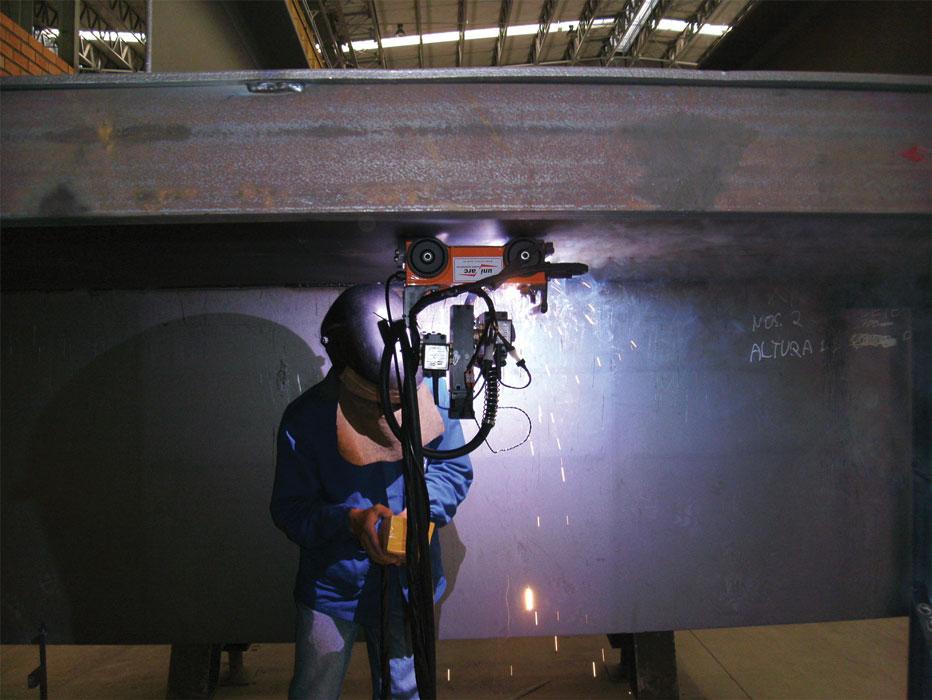- FMA
- The Fabricator
- FABTECH
- Canadian Metalworking
Categories
- Additive Manufacturing
- Aluminum Welding
- Arc Welding
- Assembly and Joining
- Automation and Robotics
- Bending and Forming
- Consumables
- Cutting and Weld Prep
- Electric Vehicles
- En Español
- Finishing
- Hydroforming
- Laser Cutting
- Laser Welding
- Machining
- Manufacturing Software
- Materials Handling
- Metals/Materials
- Oxyfuel Cutting
- Plasma Cutting
- Power Tools
- Punching and Other Holemaking
- Roll Forming
- Safety
- Sawing
- Shearing
- Shop Management
- Testing and Measuring
- Tube and Pipe Fabrication
- Tube and Pipe Production
- Waterjet Cutting
Industry Directory
Webcasts
Podcasts
FAB 40
Advertise
Subscribe
Account Login
Search
Remote-controlled tractor unit welds in hazardous, confined areas
Rail-free system improves weld consistency, reduce safety risks
- By Eric Lundin
- January 19, 2019
- Article
- Arc Welding
Few industrial processes, or families of processes, are as versatile as welding. Comprising dozens of related processes that are used on sheet, plate, tube, and pipe, welding can be divided into two large camps: manual and automated. While automated welding equipment has been available for decades, each passing year brings advances in control technology that improve welding control, capabilities, consistency, and speed. Because welders often face difficult applications, they use automated options whenever they can to mitigate health risks, work where space is limited, and weld in challenging positions.
While the main goal of an automated system is to reproduce the versatile, articulated capabilities of welding personnel, automation also improves on human capability by improving process consistency. It eliminates the subtle differences that result from differing techniques and the variations that result from fatigue and distractions.
A newcomer to this market is the Oscimatic tractor, which is made by Uniarc. A remotely controlled unit that uses the force of magnetic attraction, rather than a mechanical system, the unit travels in variable speeds on ferrous surfaces to accomplish difficult welds. Built to travel on linear courses, it uses a set of motorized cursors in the horizontal and vertical directions to position the torch before and during the weld. The standard version has an oscillator that performs the wave motion responsible for the shape and geometry of the weld bead.
While the unit isn’t steerable, the torch can compensate if the unit’s direction of travel isn’t perfectly aligned to the weld seam. Its straight-line motion is actually a benefit.
“The tractor unit was developed with a rigid four-wheel drive system that permits straight travel motions only,” said Adriano Domingues, one of the engineers who contributed to the unit’s development. “This is fundamental to keeping the tractor moving parallel to the weld joint. Also, it permits the tractor to perform weld fillets in both directions, forward and backward, without changing its position. In other words, if you have a long profile and need to make more than one fillet, you can go forward and then return to make the second pass by changing just the torch position. This capability decreases the setup time and consequently increases productivity."
The key to keeping the torch aligned with the seam is the ability to adjust the torch’s position on the fly.
“The cursor system responds to the welder’s commands,” Domingues said. “The system needs someone to monitor it all the time, at least during the adaptation time. When the welder detects a misalignment, he has 3 inches of latitude to put the torch back on the track. This kind of correction is made through the pendant control during the welding operation, so he doesn't need to stop welding.”
The welder also monitors the torch height, but if the unit has the optional automatic voltage control (AVC), he doesn’t have to. The AVC measures the arc voltage variation and uses that information to raise or lower the torch accordingly.
The welder controls the unit by means of an ergonomic pushbutton controller that can actuate all of the controlled functions—arc voltage and current; tractor speed and wire feed speed; and torch position, oscillation parameters, and dwell time. The specific torch is fixed to the oscillating mechanism through a hinged clamp in three orthogonal axes for positioning speed and accuracy. It has enough axes of control to replicate the actions of a wrist, and thereby mimics the torch motions used in manual welding.
Domingues noted that the parameters governed by the power source—arc voltage, current, and wire speed—are beyond the capability of the company’s standard pendant, but an auxiliary pendant is available to control these parameters remotely. The user provides the make and model number of the power supply, and Uniarc does the rest.
The commands are rendered in common welding terms and expressed numerically in the digital display. The command button is mounted inside a protective shield with appropriate lenses that allow the welder to view the welding and interact with the commands of the unit in real time. The LCD shows parameters regarding control, inspection, and quality assessment.
The wireless pushbutton communicates with the tractor unit through a 2.4-GHz radio frequency at up to 30 yards. The rechargeable battery works for eight hours continuously, and it can be charged when the unit is working.
Because it’s programmable, works in confined spaces, and performs long, complex welds, it is well-suited to large projects involving code welding, such as tanks and pressure vessels.
Capabilities
While the unit’s permanent magnets make it well-suited for welding on steel alloys, this isn’t a strict limitation. It can be used on stainless steels and aluminum alloys in the flat position and special circumstances. Its magnetic fastening system does not transfer magnetism to the base material, so it doesn’t have an impact on the welding process.
On ferrous materials, it can weld in any position as long as the tractor can grip the material. And, as far as Domingues knows, it’s the only commercially available unit that, in its standard version, can perform inside a gas sphere or a tank dome.
Because the operator works remotely, the risks associated with the welding arc, heat, and fumes are minimized. In other words, the programmer doesn’t have to limit the voltage and current parameters in consideration of the operator’s health, safety, and comfort. The programmer can program the machine for the highest possible deposition rates, limited only by the equipment’s capacities and the consumable ratings.
Its versatility is further enhanced by its ability to use a variety of consumable types. The machine works with solid wire for gas metal arc welding and flux-cored wire for flux-cored arc welding, but it isn’t limited to these processes. It also performs gas tungsten arc welding when outfitted with a proper torch and a cold wire feeder, Dominguesw said.
Productivity
The productivity of the Oscimatic is directly related to the work to be performed. Because the unit isn’t prone to fatigue, it provides a productivity benefit on simple, common welds and increasing benefits on welds of increasing difficulty. For example, out-of-position welds or simple welds in awkward locations—such as vertical, overhead, or a horizontal weld near a floor—illustrate the unit’s capabilities. Situations that involve the highest deposition rates or longest cord lengths yield the highest productivity gains because the unit welds continuously.
In the company’s estimation, the unit’s productivity equals that of three welders, generating, in cost reduction, an economy of two welders:
• Displacement speed- The constant travel speed relative to the energy parameters contribute to the weld’s geometry and enhance productivity. The maximum traveling speed is 51.2 inches per minute (IPM).
• Torch travel- The torch positioning capability in the vertical and horizontal axes is 2.75 in. After the unit is programmed, the torch position isn’t fixed, but it can be modified by trajectory corrections in real time by the operator as the unit progresses along the joint.
• Oscillating movement- By using variable or constant amplitudes, the welder can program proportional weld bead enlargement and improves penetration. The torch’s horizontal oscillation travel capability is 0 to 0.95 in. Controlled dwell times at the end of each oscillation half-cycle improve weld bead quality and prevent undercut. The programmable dwell time is 0 to 5 sec.
• Stitch welding- The unit can accomplish rapid speed between two fillets at its stated maximum traveling speed, 51.2 IPM.
• Attractive force- The permanent magnets provide a base that clings to the plate for vertical jobs, delivering 88 pounds of force. When configured in a single torch setup in the basic configuration, the unit weight 19.9 lbs., meaning the ratio between the weight and the attractive force is 0.225.
Capitalizing on Welder Expertise
Rather than replace a welder, an automated unit leverages the welder’s skill and competence, using the welder’s knowledge to enhance productivity, quality, and consistency. Also, because it provides three welding aspects—control, inspection, and quality assessment—it can be used by less-skilled welders. It also reduces fatigue by eliminating uncomfortable working positions and allows the operator to keep a substantial distance away from the heat, fumes, and electromagnetic radiation.
Uniarc, www.uniarc.com.br/home-eng.html
About the Author

Eric Lundin
2135 Point Blvd
Elgin, IL 60123
815-227-8262
Eric Lundin worked on The Tube & Pipe Journal from 2000 to 2022.
About the Publication
Related Companies
subscribe now

The Tube and Pipe Journal became the first magazine dedicated to serving the metal tube and pipe industry in 1990. Today, it remains the only North American publication devoted to this industry, and it has become the most trusted source of information for tube and pipe professionals.
start your free subscription- Stay connected from anywhere

Easily access valuable industry resources now with full access to the digital edition of The Fabricator.

Easily access valuable industry resources now with full access to the digital edition of The Welder.

Easily access valuable industry resources now with full access to the digital edition of The Tube and Pipe Journal.
- Podcasting
- Podcast:
- The Fabricator Podcast
- Published:
- 04/16/2024
- Running Time:
- 63:29
In this episode of The Fabricator Podcast, Caleb Chamberlain, co-founder and CEO of OSH Cut, discusses his company’s...
- Trending Articles
Zekelman Industries to invest $120 million in Arkansas expansion

3D laser tube cutting system available in 3, 4, or 5 kW

Corrosion-inhibiting coating can be peeled off after use

Brushless copper tubing cutter adjusts to ODs up to 2-1/8 in.

HGG Profiling Equipment names area sales manager

- Industry Events
16th Annual Safety Conference
- April 30 - May 1, 2024
- Elgin,
Pipe and Tube Conference
- May 21 - 22, 2024
- Omaha, NE
World-Class Roll Forming Workshop
- June 5 - 6, 2024
- Louisville, KY
Advanced Laser Application Workshop
- June 25 - 27, 2024
- Novi, MI



























